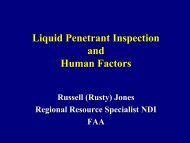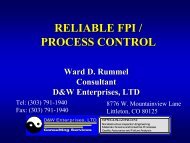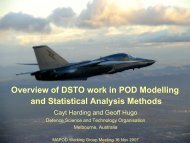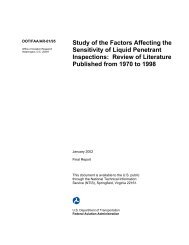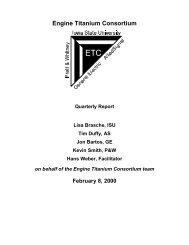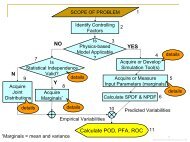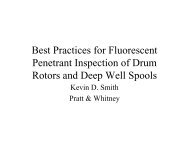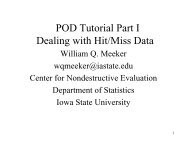Engine Titanium Consortium - Center for Nondestructive Evaluation ...
Engine Titanium Consortium - Center for Nondestructive Evaluation ...
Engine Titanium Consortium - Center for Nondestructive Evaluation ...
You also want an ePaper? Increase the reach of your titles
YUMPU automatically turns print PDFs into web optimized ePapers that Google loves.
ehavior of the transducers. This ef<strong>for</strong>t will begin as part of Task 1.1 and 1.2 which will concentrate<br />
on fixed focus transducers. Two blocks (one <strong>for</strong> fixed-focus and one <strong>for</strong> phased array) suitable <strong>for</strong><br />
the evaluation of subsurface focused transducers will be manufactured to provide experimental<br />
data with consideration given to samples available in 1.3.1. Based on this exercise, modifications<br />
will be made to model input parameters or to the model code to improve the prediction accuracy.<br />
Attention will also be paid to selection of transducer materials with consistent and measurable<br />
properties, <strong>for</strong> example the machining of lenses from solid material rather than using cast-in-place<br />
epoxy. Coordination with transducer and system vendors is expected with the objective of ensuring<br />
that results of this ef<strong>for</strong>t impact the per<strong>for</strong>mance characteristics of future products used in jet engine<br />
inspection.<br />
Surface Finish Effects: The effect of surface finish on inspectability will be determined. Surface<br />
finish requirements are anticipated to be more stringent at the higher sensitivity inspections<br />
necessary <strong>for</strong> <strong>for</strong>gings (compared to billet) and will be a focus of study in this subtask. Empirical<br />
and theoretical approaches will be used to assess the relationship between surface finish and<br />
inspectability. Empirical studies will be limited to 100 machining passes spread across five 13”<br />
diameter by 2” thick pancake samples. Results will be implemented in the UT modeling tools.<br />
Transducer Design and Selection: The ultrasonic beam properties (frequency, depth-of-field,<br />
diameter, bandwidth, mode, etc.) required to produce an acceptable 1/128” FBH calibration (FBH<br />
@ 80%, Ti grain noise < 50%) will be defined. Fixed focus transducers <strong>for</strong> flat entry surfaces will be<br />
designed, manufactured, and evaluated using appropriate ETC test specimens as necessary. An<br />
assessment of the transducers (producing the above determined ultrasonic beam properties)<br />
necessary to inspect the three OEM <strong>for</strong>gings will be made. Any additional required transducers will<br />
be designed and manufactured. A commercial source <strong>for</strong> such transducers will be established.<br />
Productivity Improvement: It was shown in Phase I that inspection sensitivity improvements will, in<br />
general, increase the time required <strong>for</strong> the inspection. Fixed-focus transducer inspection<br />
approaches have the advantage of being expandable (in an economical fashion) to include the<br />
collection of data from multiple transducers simultaneously. This approach has the potential to<br />
offset the productivity losses which will likely occur from the increased inspection sensitivity<br />
required by this task. In order to meet the inspection time goals <strong>for</strong> this task, a study will be made<br />
of the OEM <strong>for</strong>gings to determine potential areas of productivity improvement. A maximum<br />
productivity approach will be defined and developed <strong>for</strong> evaluation in the laboratory demonstration.<br />
Fixed Focus Laboratory Testbed: Laboratory testbed <strong>for</strong> the development and evaluation of the<br />
fixed-focus inspection approach <strong>for</strong> a 1/128” FBH calibration <strong>for</strong>ging inspection with digital C-scan<br />
data acquisition and SNR based rejection criterion will be established. Additional transducers<br />
necessary to inspect the OEM <strong>for</strong>gings will be designed, manufactured and tested. Scan plans <strong>for</strong><br />
the selected OEM <strong>for</strong>gings will be developed with model-based support. A limited number (1-2) of<br />
each of the selected <strong>for</strong>gings will be inspected per the scan plan. Per<strong>for</strong>mance of the fixed focus<br />
inspection approach <strong>for</strong> <strong>for</strong>ging inspection will be documented. Alternative inspection technologies<br />
will be identified using the experience base of the four partners, as well as NTIAC.<br />
Phased Array Inspection: An evaluation will be made of available phased array technology to<br />
determine which are potentially production-ready and capable. At this time, the digital focused<br />
array transducer system DFATS annular phased array and the R/D Tech 2D array are known as<br />
Quarterly Report – January 1, 2002 –March 31, 2002<br />
print date/time: 6/6/2002 - 8:39 AM – Page 55



